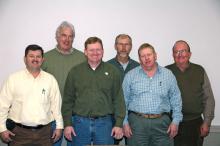Information Possibly Outdated
The information presented on this page was originally released on January 24, 2008. It may not be outdated, but please search our site for more current information. If you plan to quote or reference this information in a publication, please check with the Extension specialist or author before proceeding.
Mississippi peanut growers learn from industry experts
HATTIESBURG -- More than 80 growers from all areas of the state gathered in Hattiesburg Jan. 22 for the second annual Mississippi Peanut Growers Association meeting and short course.
The number of producers attending the 2008 meeting doubled from 2007, said association president Clayton Lawrence of George County.
“The newness of this industry in Mississippi means there is a lot we still have to learn,” he said. “This meeting is an opportunity for our growers to learn from some of the best peanut researchers in the industry.”
Mississippi jumped from obscurity in peanut production circles to a No. 9 ranking in the nation during 2006 and moved up to No. 7 in 2007. The state’s 18,000 acres produced almost 60 million pounds of peanuts last year, according to U.S. Department of Agriculture statistics.
Mike Howell, Mississippi State University Extension Service southeast district area agronomist, said the 2002 Farm Bill opened the door for peanuts in Mississippi.
“The bill eliminated the quota systems for peanuts, making it possible for more farmers to grow the crop,” Howell said. “Most of the interest has been in the southeast area of the state, but we also have growers throughout the Delta and in the northeast counties.”
The meeting featured peanut specialists from the University of Georgia, Auburn University and the University of Florida, as well as personnel from USDA and the Mississippi Department of Agriculture and Commerce. Topics ranged from the use of GPS technology in peanut production to an update on the 2008 Farm Bill.
Mississippi peanut growers face fewer disease problems than their counterparts in south Georgia because peanuts are still new to the area and the innoculum potential, or possibility for the presence of disease in the soil, is relatively low, said Georgia agronomist John Beasley.
The agronomist warned growers, however, that “South Mississippi gets more rain than south Georgia, so the disease potential in fields with reduced fungicide applications is greater.”
“The best way to keep diseases down in peanuts is a good crop rotation program,” Beasley said.
Cotton and corn are the crops recommended for rotation with peanuts. Producers were warned not to plant peanuts behind soybeans since both crops are legumes and can be attacked by the same diseases.
“Put at least one year of corn or cotton between soybeans and peanuts,” Beasley said. “Planting peanuts once every third year is the ideal situation for peanuts in a cotton/corn rotation.”
Marshall Lamb, director of the USDA Agricultural Research Service’s National Peanut Research Laboratory in Dawson, Ga., discussed the work of the 12 scientists at the lab, including research with an on-farm biodiesel production system.
“We plan to use peanuts from this year’s research plots to produce a 50/50 peanut oil/petroleum diesel blend to use in the equipment we’ll use to grow next year’s peanut plots,” he said.




